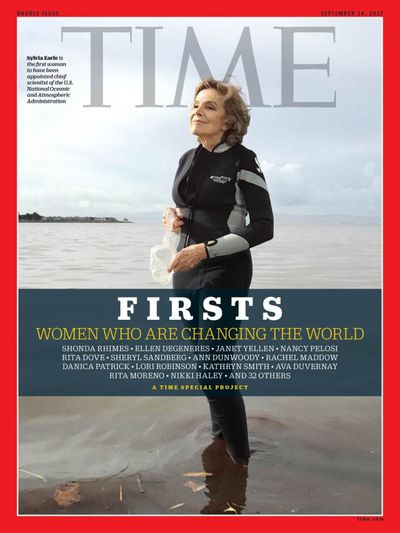The iPhone offers a high-quality camera that Apple improves with every iteration, and the photos and videos that it takes have been used for fashion runways, feature films, and other professional applications.
TIME Magazine is the latest publication to exclusively use the iPhone's camera for a photo shoot, with its new "Firsts: Women Who Are Changing The World" series, which features iPhone images captured by Brazilian photographer Luisa Dörr.
Over the course of the last year, Dörr has used an iPhone 5, iPhone 6, iPhone 6s, and iPhone 7 to capture photos of notable and accomplished women like Hillary Clinton, Oprah Winfrey, Melinda Gates, Sylvia Earle, Alice Waters, Mae Jemison, Cindy Sherman, and more.

In a TIME interview, Dörr says she uses an iPhone because it offers great pictures anytime, anywhere, and it because "feels less intrusive" to the subject when the photo is captured with an iPhone instead of a standard camera. Dörr's images are unique because she uses only natural light and sometimes a reflector to capture women who are often photographed with more lighting and production equipment.
I like the simplicity of how these pictures are made. But the best part is that as a photographer, you feel extremely light and free. It is almost as if I can make pictures with my hand. There's no noise, gadgets, tools or plugs--just the subject and myself.
I was always trying to imagine these portraits as paintings. I'm fascinated by the landscapes and topographies from women's faces, their stories and context. I'm interested in the way life and time is writing on all of them--not just with physical marks but also with more spiritual traces.
Dörr says the women she photographed were "surprised" to be the subject of a photoshoot with an iPhone and no other equipment, and that oftentimes, she did her work in just minutes. The shortest shoot was two minutes and the longest shoot lasted 20 minutes.
Each portrait was captured using the regular iPhone camera with the square format, and automatic HDR was turned on for more lighting detail in the photographs.
Powerful stories, striking portraits! Bravo @TIME and Luisa Dorr #ShotoniPhone #SheIsTheFirst https://t.co/i5hS8IFgE8 — Tim Cook (@tim_cook) September 7, 2017
Dörr's full interview can be read over at TIME, as can an accompanying piece on how TIME Director of Photography Kira Pollack discovered Dörr and recruited her to work on the project.
























Top Rated Comments
Great photos by Luisa Dörr. It's always a great reminder to see such great photos taken with a phone. It reminds me that it's not just about the gear. Sometimes when I don't have my DSLR with me, I feel that I'm unable to get great photos. However, once I pull out my phone and start shooting, it surprises me. Back in the day, I'd be a sitting duck without a dedicated camera, since phone cameras used to be terrible. While a phone isn't a replacement for a dedicated camera, it gives you a chance to get a photo that you otherwise would have never had the chance to get -- and that's really special, I think.
One is that, to the vast majority of people who look at that cover or other photos taken by the artist, they look like interesting, engaging photos. Most--and most by far I would guess--people don't look at photos like these and say "it looks flat" or "the micro-contrast is weak" or "it's not sharp enough" or "there isn't enough subject isolation" or whatever else. They see an interesting photo, and appreciate it.
And the other is the more salient point from an artistic perspective: Indeed it's true that if you took the exact same photo with an EOS-1D X mk II and an expensive lens it would be sharper, higher resolution, and have more dynamic range. It would almost certainly look better.
Except it's quite possible that the photographer couldn't take that exact same photo with an EOS-1D X mk II. As noted in the description, the subject might well have reacted differently to a photographer holding a huge camera with the shutter clicking away, or she never would have been in that particular location carrying a large camera, or whatever other nuances of the actual act of photographing another human being in situ might have come out differently.
It's the same if the photographer had tried to take the same shots with a large flash kit versus only natural light--the photo might be better lit, but what the person in it is doing would probably be less natural, and depending on the intent of the photo, less interesting.
If you've got a tripod, sufficient time, and are photographing a landscape or model, sure, a large-sensor, large-lens camera is going to produce a better photo than an iPhone in every way. And sure, there are photos that an iPhone is incapable of taking for technical reasons--available light, field of view, depth of field, bokeh. But following around a human trying to take a certain kind of photo, the act of photography itself changes the result, possibly for the worse.
Heck, I'm just a casual photographer and I've noticed it plenty of times just taking street photos while on vacation. I hold up a smartphone to take a picture, nobody even notices. I hold up my bigger camera, people look at me, stiffen up, react like they're being photographed. Occasionally the effect can be positive, but more often it results in odd expressions and less natural behavior.
Nothing about this sounds right.
This whole thing is just a lame promo for Apple. As digital cameras go (not smart phones) iPhone photo quality is near the bottom of the heap. But as a smartphone camera, the 7 is one of the best.